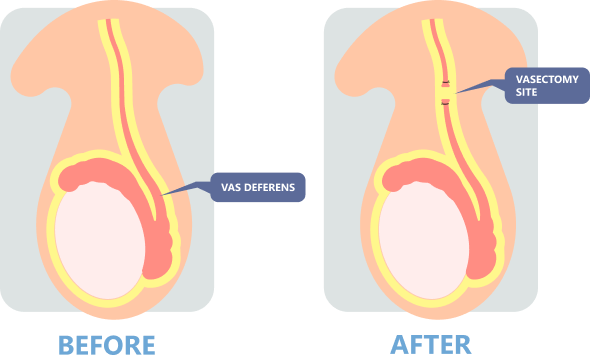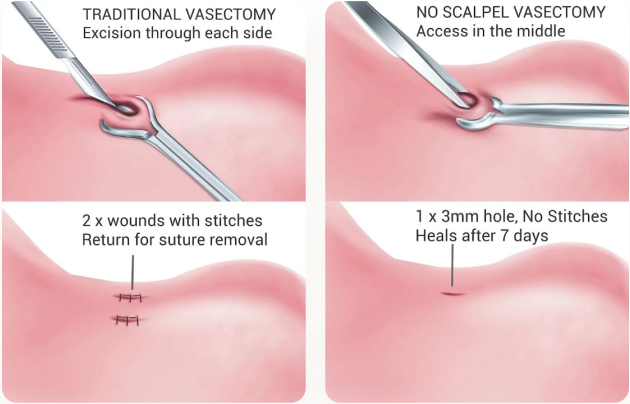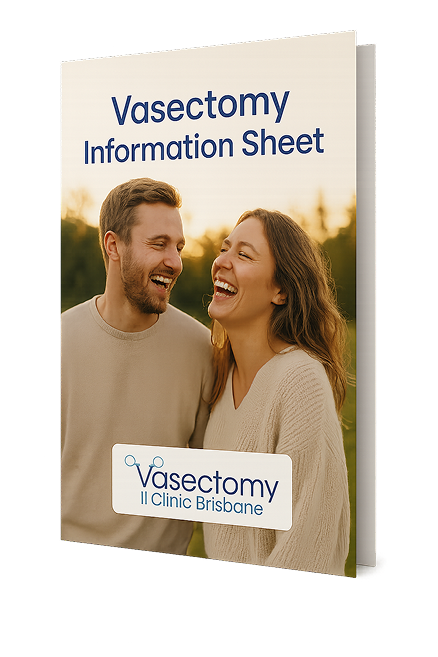No-Scalpel Open-Ended Vasectomy

Brisbane’s Trusted No-Scalpel
Vasectomy Specialists Since 1985
- Minimal Discomfort
- Faster Recovery
- Lower Risk of Complications
- Preserves Natural Function
Take Control of Your Future With No-Scalpel
Open-Ended Vasectomy
Vasectomy is male sterilisation – a simple, permanent form of contraception. It involves division of the vas deferens on each side in the scrotum, thus preventing the movement of spermatozoa from the testicles to the prostate area, where it is normally added to prostate secretions at the time of ejaculation.
The procedure is conducted at Vasectomy Clinic Brisbane under local anaesthesia in our minor operations room, with Dr Valentine attending, assisted by Mrs Roslynne Marshall, an experienced nurse.

How
Vasectomy
Works
Sperm are made in the testes and pass into the epididymis located behind each testicle where they become mature. They then pass through two tubes called the vas deferens (one on each side of the scrotum) to the region of the prostate where they combine with seminal fluid and are ejaculated through the urethra. Vasectomy interrupts this flow by dividing the two vas deferens, preventing the ejaculation of semen containing sperm.
Why
No-Scalpel,
Open-Ended
Vasectomy?
Our no-scalpel, open-ended technique offers superior comfort, faster recovery, and better long-term outcomes than traditional methods.
Minimal Discomfort
No scalpel means no cutting - just a gentle puncture for significantly less pain and anxiety.
Faster Recovery
Get back to your routine quicker with reduced swelling, bruising, and healing time.
Lower Risk of Complications
Advanced technique reduces bleeding, infection risk, and post-operative complications by up to 50%.
Preserves Natural Function
Open-ended approach maintains normal sperm flow, reducing pressure and long-term discomfort.
No-Scalpel Technique

We specialise in the No-Scalpel Vasectomy (NSV) technique, which Dr Valentine prefers over traditional methods. During a No-Scalpel Vasectomy:
- A tiny needle anaesthetises a small area of skin and the vas deferens at the front of the scrotum
- A small hole is made using a pointy haemostat (no cutting required)
- Each vas deferens is lifted through the hole and divided
- The upper end is sealed using cautery
- The ends are separated and placed out of alignment with dissolvable ties
- No sutures are required and the wound typically seals by the next day
This advanced technique reduces bleeding risk and promotes faster healing compared to traditional methods that require incisions and sutures.
What to Expect
During the Procedure
- Takes approximately 20 minutes
- Performed under local anaesthetic
- No general anaesthesia required
- About 95% of men are suited to local anaesthetic vasectomy
After the Procedure
Following a vasectomy, patients
should notice:
- No change in semen volume
- No change in sex drive
- No change in climax sensation
- No change in the testes or scrotum
- No change in erections
Recovery Timeline
- Day 1: Rest at home, apply ice packs, wear supportive underwear
- Day 2-3: Light activities, continue scrotal support
- Day 4+: Gradual return to normal activities
- 7 days: Sexual activity may resume when comfortable
Pre-Operative
Preparation
Keep These Things in Mind – It Will Help You and Us
- Arrange time off work/normal activities - Plan for recovery time
- Avoid aspirin for 10 days and all other anti-inflammatory medications for 24 hours pre-op - These may promote bleeding by inhibiting blood platelet function
- Prepare the pubic area and scrotum two nights before - A lather and shave is suitable, though good results often follow clipping or cutting hair short, then using a hair removal cream such as Nair or Veet. Follow the product instructions carefully, and use the low irritant or 'for sensitive skin' variety of the product
- Shower before leaving for the procedure - You may take a light breakfast on the day
- Arrive on time, at least 20 minutes before your appointment time - Allow for peak hour traffic delays
- Bring cold packs in a small esky - If you have to travel outside of the metropolitan area to get home
Care After the
Procedure
- Wear jockey style underpants for good support - Essential for proper recovery
- Apply cold packs immediately upon arriving home - Apply the cold pack to the scrotum with a thin chux wipe or similar to prevent skin sticking. Apply for 15 minutes every hour for day 1 postop, ie the day of the procedure, until retiring that night. A cold pack is the best pain relief
- Rest on day 1 - Read a book, watch television, snooze, but don't undertake physical exertion on day 1. On days 2&3 you may be up and about but avoid lifting and straining. From day 4 activities may be gradually ramped up
- Use panadol or ibuprofen for pain relief if necessary
- Avoid alcohol for 24hrs - It causes blood vessel dilation and may therefore contribute to swelling
- Don't shower on day one post-op - But you may shower from day two onwards
- Remember to use contraception post operatively - Until a 4 month post vasectomy semen analysis and clearance from the surgery. You will be given a list of these recommendations on the day of the procedure, as well as a pathology request form, container and instruction for the 4 month post-vasectomy test. You will receive a reminder from the surgery when the test is due, and a notification of the test result
Get Our Complete
Vasectomy Guide
Get all the essential information you need to make an informed decision. Our comprehensive guide covers the procedure, recovery, risks, and what to expect every step of the way.

Vasectomy Cost
Same Day Pre-Operative Consult and Procedure
Both the preoperative consultation and the vasectomy procedure are performed on the same day.
Cost Breakdown:
- Total cost: $795
- Medicare rebate: $228
- Your out-of-pocket cost: $567
Booking Requirements:
- A $100 vasectomy booking fee is required for all procedures
- This booking fee is deducted from your procedure day payment
- You may change your appointment, but the booking fee may be forfeited if you fail to attend or cancel/change with less than 48 hours’ notice
Why Choose Us
Decades of
Experience
Over 35 years performing vasectomies with thousands of successful procedures completed.
Gentle
Technique
Specialising in no-scalpel, open-ended methods for superior comfort and outcomes.
Same Day
Service
Consultation and procedure available on the same day for your convenience.
24-Hour After-Care
Support
Round-the-clock assistance and guidance during your recovery period when needed.
Convenient
Locations
Multiple clinic locations across Australia, making quality care accessible near you.
Medicare Rebate
Available
Eligible patients can claim Medicare rebates to reduce your out-of-pocket expenses.
Meet
Your Doctor

Dr Matthew Valentine
Dr Valentine completed his medical degree at the University of Adelaide in 2000. Following a two year internship and residency at the Royal Adelaide Hospital Dr Valentine spent 5 years working full-time as a Medical Officer in the Royal Australian Air Force. This included several overseas deployments and the coordination and conduct of aeromedical retrievals both overseas and within Australia.
Dr Valentine is a Fellow of the Royal Australian College of General Practitioners and holds the position of Designated Aviation Medical Examiner with the Civil Aviation Safety Authority.
Dr Valentine has been performing vasectomies in Brisbane since 2008, having initially trained in the traditional technique with Dr Greg Silver. He has subsequently undergone further training in the USA, specialising in the No Scalpel Vasectomy Technique. Having performed over 17000 vasectomies, Dr Valentine currently performs vasectomies in metropolitan Brisbane, Regional QLD, Sunshine Coast, Gold Coast, Canberra, Perth, Darwin, Regional NSW and Regional Victoria.
Dr Valentine is married and lives in Brisbane with his wife and daughter. In his spare time he enjoys trail running, hiking and mountain biking.
Dr Valentine completed his medical degree at the University of Adelaide in 2000. Following a two year internship and residency at the Royal Adelaide Hospital Dr Valentine spent 5 years working full-time as a Medical Officer in the Royal Australian Air Force. This included several overseas deployments and the coordination and conduct of aeromedical retrievals both overseas and within Australia.
READ MORE
Dr Valentine is a Fellow of the Royal Australian College of General Practitioners and holds the position of Designated Aviation Medical Examiner with the Civil Aviation Safety Authority.
Dr Valentine has been performing vasectomies in Brisbane since 2008, having initially trained in the traditional technique with Dr Greg Silver. He has subsequently undergone further training in the USA, specialising in the No Scalpel Vasectomy Technique. Having performed over 17000 vasectomies, Dr Valentine currently performs vasectomies in metropolitan Brisbane, Regional QLD, Sunshine Coast, Gold Coast, Canberra, Perth, Darwin, Regional NSW and Regional Victoria.
Dr Valentine is married and lives in Brisbane with his wife and daughter. In his spare time he enjoys trail running, hiking and mountain biking.
FAQ
What do I do prior to the procedure?
Prepare the pubic area and scrotum two nights before. A lather and shave is suitable, though good results often follow clipping or cutting hair short, then using a hair removal cream such as Nair or Veet. Follow the product instructions carefully, and use the low irritant or ‘for sensitive skin’ variety of the product. Bring two pairs of supportive underwear to the procedure. Patients should refrain from any aspirin, ibuprofen, or alcohol on the night before and the day of their vasectomy. They should avoid fish oil supplements for 7 days prior to the procedure.
Are there any age restrictions?
There are no age restrictions. Vasectomy should only be considered by those couples whose family is complete: it is meant to be a permanent procedure. Microsurgical reversal of vasectomy has a moderate failure rate of achieving pregnancy, due to either technical issues, re-stenosis, or anti-sperm antibodies following the original vasectomy. Patients considering vasectomy should carefully consider the implications of no longer being able to sire children, in the context of relationship breakdown, changed circumstances, death of existing child etc. Younger couples without children, or younger men not in a stable relationship should generally avoid vasectomy until 30 years of age. A consultation will generally allow the doctor to better understand patient requests in these circumstances.
Does this affect my sexual performance and volume of ejaculation afterwards?
Sexual performance is not affected at all, and you can expect to see no changes in the volume of ejaculate post procedure. Studies have shown that having had a vasectomy often enhances couples’ sexual relationship.
What can I expect afterwards?
Patients can expect some bruising and soreness for several days following the procedure. Patients will be fit to conduct sedentary duties the day following the procedure but should avoid any heavy lifting for three days. Patients should wear 2 pairs of supportive underwear for at least three days following the procedure and for at least 7 days if they are conducting any lifting or more strenuous activities. Bring the underwear to the procedure in order to wear home. Patients will need to continue their contraception until a semen test conducted at 4 months following the procedure confirms the absence of sperm. Read more about vasectomy aftercare.
Is the procedure reversible?
The procedure should be seen as irreversible. In 60-70% of cases the procedure may be able to be successfully reversed and a pregnancy achieved. Reversal is expensive and success is not guaranteed. Patients who are considering reversal should not proceed with a vasectomy.
How long after the procedure can I have intercourse?
It is recommended patients wait for 7 days and until discomfort following the procedure has settled. It is not uncommon for patients to notice some blood in the ejaculate in the first few ejaculations following vasectomy.
Can I drive home after my vasectomy?
Patients may drive home following their procedure. If you have any prior history of fainting though it is recommended you have someone drive you home following your procedure. There is a risk patients may experience delayed light headedness following the procedure. Note that a car accident or flat tire may in some cases lead to complications following a vasectomy.
When can I fly following my vasectomy?
It is recommended that patients not fly for at least 48 hours following their vasectomy.
Can I have my vasectomy counselling and procedure on the same day?
For convenience patients may have their pre vasectomy counselling and procedure on the same day. Patients should be aware that there is a slight chance they will be assessed as being unsuitable to have the procedure (due to inability to locate their vas deferens). This occurs in 1-2% of patients.
Procedure Risks
Infection
Although sterile technique, gloves, drapes, instruments etc are used there remains the possibility of infection being introduced during the procedure or afterwards in the bacteriologically rich pubic/scrotal environment. This is mitigated against by good skin preparation and by not showering on the day following your procedure.
Bruising / Bleeding / Swelling
The scrotum is loose baggy tissue, which like eyelid tissue can readily accept swelling. Good scrotal support (double pair of jockey type underpants) should be worn from leaving the surgery. Cold packs (usually as small packs of frozen peas) should be applied hourly for 15 minutes, commencing on arrival home after the procedure, and continuing until retiring that night.
Pain / Discomfort
Pain and discomfort is to be expected for a few days after the procedure, but may be minimised with good support, cold packs and the use of panadol or panadeine. Some men (approximately 30%) experience congestive/full feelings, intermittently, in the epididymis in the first 3-4 months, until such time as the body down-regulates sperm production to match sperm break-down rates in the epididymis. Long term orchalgia (testicular discomfort) is a very infrequent outcome, and thought to be related to irritation of the nerves running in the spermatic cord. This is a low risk with appropriate technique and instruments, but might rarely require further intervention.
Sperm Granuloma
Sperm Granuloma is a local foreign body reaction to sperm leaked from the divided ends of the vas deferens. They are felt as a small lump some months after vasectomy and generally require no treatment.
Recanalisation
There is an extremely low risk of the tubes rejoining after a vasectomy. Were this to occur an unplanned pregnancy could result. Vasectomy remains the most effective form of permanent contraception available, including tubal ligation.
